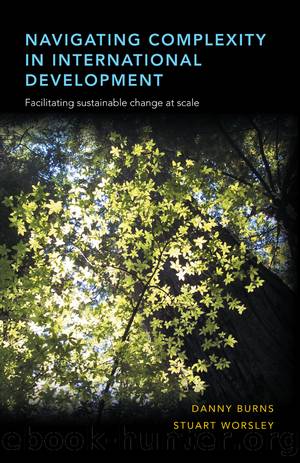Navigating Complexity in International Development: Facilitating Sustainable Change at Scale by Danny Burns & Stuart Worsley

Author:Danny Burns & Stuart Worsley
Language: eng
Format: epub
Publisher: Practical Action Publishing Ltd
Figure 4.5a Macro level analysis of climate change dynamics in Afiedenyigba, Ghana original
Figure 4.5b Macro level analysis of climate change dynamics in Afiedenyigba, Ghana – transcribed
Source: Adapted from Harvey et al. (2012)
Even in a relatively simple diagram with no directional arrows showing causality and no positive and negative signs, it is easy to see what the relationships are. One of the attractive features of these maps is that they are also easy to transfer and to explain to people who are not part of the inquiry. Just as in the Kamukunji example that we described earlier, direct positive outcomes emerged from the inquiry alone and how it was communicated by the radio station. This account describes the outcome:
While the longer term impacts of this research are still emerging (the project concluded in August 2011) there are already concrete outcomes beginning to emerge from the process at the level of the communities themselves. Among the more marked outcomes to date has been the initiation of a new dialogue between community members of Azizanya and local and traditional authorities from the area. Azizanya as we mentioned above, is a community facing rapid coastal erosion and a tense related conflict over land tenure rights between fishing communities and local authorities looking to develop coastal land for tourism. Broadcasters report that the community durbar helped to renew an open (and broadened) dialogue on these issues, which have been the source of significant conflict and secrecy to date. Further, upon hearing the broadcast dialogues about these issues, neighbouring communities facing similar challenges approached the broadcasters requesting to be brought into the investigation as well. (Harvey et al., 2012: 111)
Systemic story analysis
So far we have shown how community-level maps can be built from stories of individuals and from stories about the community. From many micro stories we were able to get a picture of the macro patterns. But we can also look at this the other way around. From the individual stories we can start to understand how the macro patterns interact with individuals’ lives – both creating spirals of decline and ‘positive deviance’ (Pascale et al., 2010) which enable people to create positive trajectories even where their peers are unable to.
Storytelling reveals system dynamics, which can be described in narrative form. It helps us to understand how change happens. As one explanation on the Wikipedia page on narrative inquiry nicely explains ‘Story collecting as a form of narrative inquiry allows the research participants to put the data into their own words and reveal the latent ‘why’ behind their assertions’ (Wikipedia, n.d.). Understanding why things happen is necessary in order to understand the relationship between things that happen (whether causal or not). In our narrative work we look at three types of stories:
Individual stories that can tell us a lot about how and why things happen. For example, we may only have one story about how a disabled person moved from begging into employment, but it can tell us something about the factors which made that possible – which can then be researched more deeply.
Download
This site does not store any files on its server. We only index and link to content provided by other sites. Please contact the content providers to delete copyright contents if any and email us, we'll remove relevant links or contents immediately.
The Secret History by Donna Tartt(16621)
The Social Justice Warrior Handbook by Lisa De Pasquale(11489)
Thirteen Reasons Why by Jay Asher(7788)
This Is How You Lose Her by Junot Diaz(5769)
Weapons of Math Destruction by Cathy O'Neil(5036)
Zero to One by Peter Thiel(4824)
The Myth of the Strong Leader by Archie Brown(4789)
Promise Me, Dad by Joe Biden(4447)
Beartown by Fredrik Backman(4415)
Stone's Rules by Roger Stone(4415)
How Democracies Die by Steven Levitsky & Daniel Ziblatt(4398)
The Fire Next Time by James Baldwin(4342)
100 Deadly Skills by Clint Emerson(4076)
A Higher Loyalty: Truth, Lies, and Leadership by James Comey(4032)
Rise and Kill First by Ronen Bergman(4012)
The David Icke Guide to the Global Conspiracy (and how to end it) by David Icke(3881)
The Farm by Tom Rob Smith(3872)
Secrecy World by Jake Bernstein(3782)
The Doomsday Machine by Daniel Ellsberg(3730)
